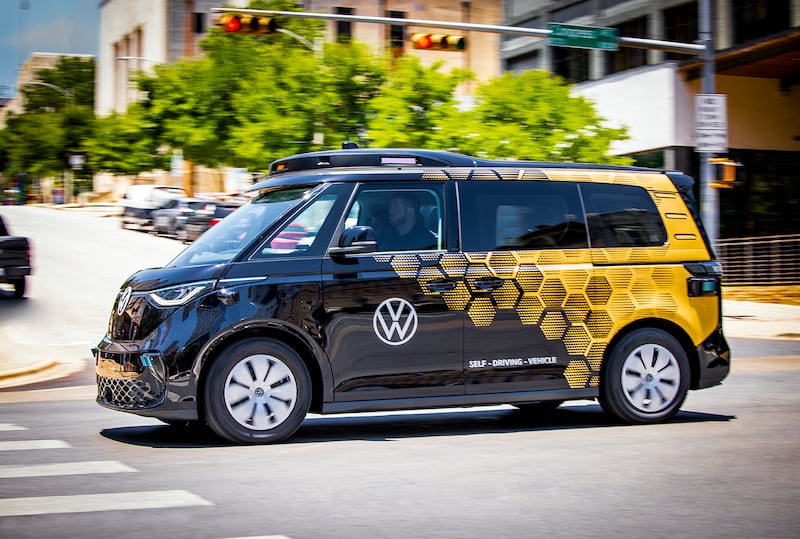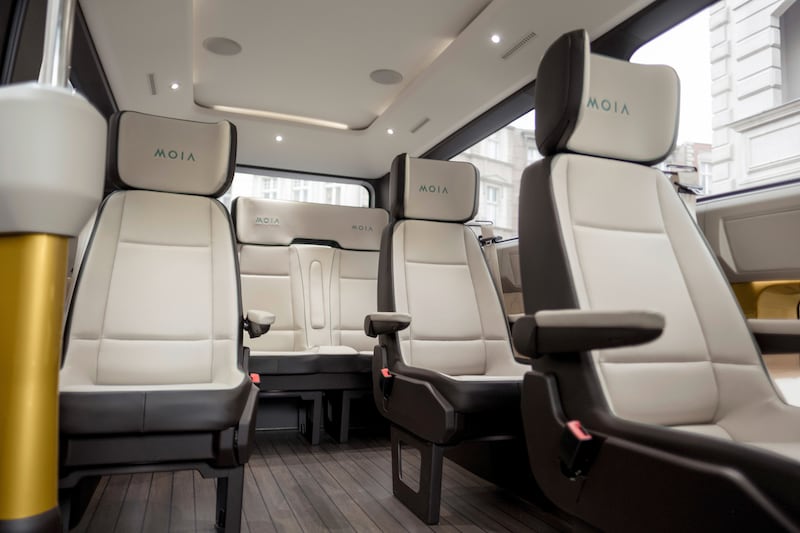Volkswagen says that it is doubling down on its plans for autonomous, on-demand ride-sharing services and that it plans to have the first test drives for customers, in Germany, using self-driving vehicles by the end of this year. Some self-driving prototypes are already running trials in Hanover, and fully operational, paid-for services could begin as soon as 2026.
VW is developing autonomous services through its MOIA offshoot and has just signed up a big deal with tech provider Mobileye. This firm will develop and supply software, hardware components and digital maps for the “self-driving” ID. Buzz AD which will eventually, it is hoped, form a cornerstone of the MOIA ride-sharing service (the word MOIA comes from maya which means magic or illusion in some Indian dialects. You’ll notice that the M and the A of the MOIA badge are the W and V of VW turned upside-down, with the OI in the middle representing an electric on/off switch).

“Bringing autonomous shuttles on the road in large quantities requires co-operation from strong partners,” said Christian Senger, VW’s head of autonomous driving programmes “We are developing the first fully autonomous large-scale production vehicle, using Mobileye’s digital driver. The partnership takes advantage of the automated driving system synergies in the Volkswagen group; depending on the expansion level, modules can be shared across SAE levels from 2+ to 4, driving down cost and facilitating the ability to scale.”
SAE Level 4 autonomous driving is defined as a vehicle that can drive itself within preset geographic parameters, such as on a specific route around a city. Mobileye’s tech will include two independent high-performance computers as well as 13 cameras, nine lidar and five radar units, each system is capable of producing 360-degree surroundings. The set-up is designed to be connected to the cloud so that it can receive “swarm” data from other vehicles in the area.
100 Years of Solitude review: A woozy, feverish watch to be savoured in bite-sized portions
How your mini travel shampoo is costing your pocket and the planet - here’s an alternative
My smear test dilemma: How do I confess that this is my first one, at the age of 41?
The 50 best films of 2024 – the top 10 movies of the year
VW has been testing its MOIA service in Hamburg since 2019, albeit so far with human drivers instead of robots. What’s it like to use? Surprisingly familiar, at least for now.
The minibus-shaped vehicle — ours was based on a Crafter van, rather than the ID. Buzz — pulls up outside our hotel, and just as with any bus you climb aboard through a large door which opens next to the driver’s cab. In the back are six seats — three individual perches and a bench of three seats at the back. The seats are covered in a soft, pale vinyl and have large wraparound headrests which grant you a little privacy if you’re sat in one of the individual seats. They’re also very comfortable, far more so than you’d find in a conventional city bus.

However, the phrase “conventional city bus” is never far from one’s mind because that’s kind of what MOIA is offering, at least for now. The service runs on regular routes, and doesn’t drop you from door to door — you have to get to it. So what’s the advantage, beyond the comfy seats, over a regular bus?
“We are aiming for mobility as a service, not just for people but for goods, too,” Christian Senger told The Irish Times. “We have a fear in this class, because we need to get the cost of highly available public services down, and this is only available with autonomous technology.”
Hence VW’s slightly ominous promise that while it will use human drivers in the early stages of MOIA, and those humans will remain on board as emergency backups in the initial phases of autonomous operation, eventually they too will be made redundant. A case of the machines taking our jobs?
Well, possibly not. Possibly more a case of the machines taking jobs that no human particularly wants right now. According to Sasha Meye, MOIA’s chief executive in Hamburg: “We are aiming for a wait time in the city of less than five minutes, so this is truly on-demand. So why do we need autonomous? Because for 5,000 vehicles we would need 15,000 drivers, and there is at the moment no way, in a western European city such as Hamburg, to hire that many people. The second aspect is flexibility — urban mobility is a beast, and it’s very narrow in its demand pattern. It’s two hours in the morning and five-to-six hours in the evening, plus other usage cases at the weekend. Drivers want to drive for shifts of eight hours, plus they have human needs such as breaks and so on. With autonomous vehicles, we will have much higher levels of flexibility and we can deploy the fleet where and when it’s actually needed, really fulfilling the purpose of being an on-demand service.”
As Meyer puts it, autonomous cars don’t get sick and they don’t drive erratically (well, according to the software engineers they don’t — let’s see how a real swarm of autonomous cars copes with other human-driven vehicles on city streets before we judge), they don’t speed or miss turns and so can provide a service that’s far more reliable, with more predictable travel times.
Pricing too will be critical, and MOIA aims to pitch its services priced roughly halfway between the cost of getting a conventional bus and hiring a taxi.
As the Crafter-based MOIA transport wends its way through Hamburg, with sunshine — chilled by the last few cold days of winter blending into spring on the river Elbe — streaming in through the windows, it’s hard not to be beguiled. The black-and-gold colour scheme looks classy (it reminds me of Lotus’ one-off turbine-powered 56B Formula One prototype from 1971, which only raced once, just down the Autobahn at Hockenheim for the German Grand Prix) and gives the MOIA vehicles a reassuring air. The cabins are certainly roomy and comfortable, and of course, our vehicle — scrubbed and pressed for presentation to scruffy journalists — is spotless within. How long will they remain in that condition?
Meyer seems confident that VW has come up with a solution to any potential anti-social, or just plain rude, behaviour: “We think with autonomous vehicles, you still need a human factor so that people will accept it. So there will be ‘guardian angels’ who will take care of vehicle safety.” Those guardians will be based at control hubs — such as the one already up and running in Hamburg — and will use a combination of in-car cameras and other sensors, plus the helping hand of AI, to try to keep both occupants and vehicle safe and secure.
Meyer also wants MOIA to be more than simply an independent transport provider, just one of many apps that live in your smartphone waiting to be used. He wants the service to become an integral part of public transport provision in cities where it operates.
“We have a strong background in collaborating with cities and authorities to really cater the service to their needs” says Meyer. “And in the future, we will increase our collaboration [with] public transport operators so that we can bring this model alive in a franchise approach. We are convinced that combining mass-transit trains and buses with ride-pooling will be a game-changer for mobility. We will offer the service quality that customers deserve and they know from their cars with the reliability and availability that they expect. So our vision is that we use the autonomous vehicles to democratise on-demand mobility in Europe for the common good.”
Finally, we reach our destination. The journey has taken about 30 minutes to cross a large chunk of Hamburg’s urban and industrial sprawl. It has been pleasant and comfortable, like a cross between — as MOIA promises — a bus and a private car. While the built-in redundancy of the human element still makes me feel a touch queasy, there’s no denying the appeal of such a service if it can be rolled out affordably and reliably.
- Listen to our Inside Politics Podcast for the latest analysis and chat
- Sign up for push alerts and have the best news, analysis and comment delivered directly to your phone
- Find The Irish Times on WhatsApp and stay up to date





